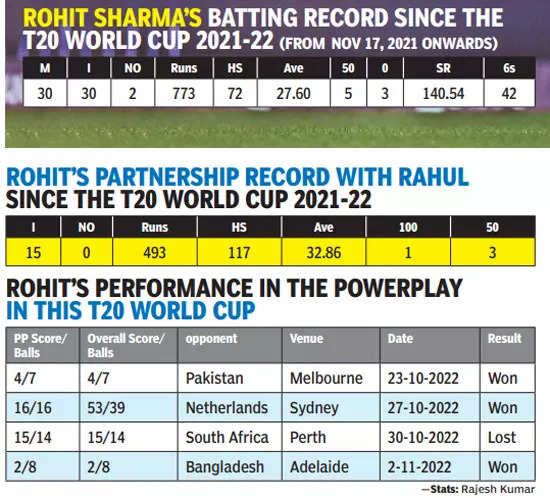
MELBOURNE: After some intense games and constant travel, it was time for Team India to unwind and enjoy a first real rest day here on Friday. The team has ticked most oxes here, and with only a last league game against Zimbabwe to go on Sunday, the downtime will give Rohit Sharma and the team management time to reflect over the last
remaining weak link: a few underwhelming batting performances in the Powerplay.
In the lead-up to the World Cup, all the talk had been of aggressive Powerplay posturing. The openers were tasked with adopting a more belligerent approach first-up, since it was felt a slow start was one of the reasons India did badly in last year’s T20 World Cup in the UAE.
However, the early summer conditions and the cold and damp here in Australia hasn’t really allowed such an approach, leading to a shifting of gears midway. The one direct beneficiary has been Virat Kohli, who had made it clear in the Asia Cup itself that he would take his time and work the ball around before upping the ante.
“I was desperate to do something that wasn’t in my game,” Kohli had admitted after the century against Afghanistan. “I can hit sixes when the situation demands, but I’m better at finding gaps and hitting boundaries.”
Should openers Rohit Sharma and KL Rahul, who have at times struggled to force the pace in the first six overs in this World Cup, adopt a similar clarity of approach? Simply put, given the conditions, is it time for India to temper their expectations from the Powerplay and preserve early wickets?
Against Bangladesh in Adelaide, with the ball darting around, India started in an edgy fashion against the pace of Taskin Ahmed, Shoriful Islam and Hasan Mahmud. The first nine balls of India’s innings yielded just one run before Rahul flicked Shoriful for a six over the square leg boundary.
Taskin’s third over again yielded just one run, with the bowler probing the corridor with length balls. The over included a dropped catch as Rohit looked to extract maximum from a slightly short of length delivery on off, and Hasan Mahmud at backward square leg put down a straightforward chance.
Mahmud made amends when handed the ball next, luring Rohit again with a short delivery outside off. India’s captain played a shot of a man not in form: he looked to upper cut but found the fielder at backward point. 11/1 in 3.2 overs. India eventually managed just 37/1 in the first six overs.
Rohit’s risky approach, which is something new for someone who has scored so many runs by getting his eye in whatever the format, was on view against the Netherlands in Sydney as well: try as he might, he could not break free in the Powerplay, though eventually he scored a 39-ball 53 at 135.89.

After the game, Rohit, who scored 16 from 16 balls in the Powerplay, would go on to say, “I’m not entirely happy with the way I batted. I wouldn’t say it was a perfect knock. Just to get some runs under my belt was good. I have to get runs, good looking or ugly it doesn’t matter.”
It was the first real admission that the lack of runs from his blade was beginning to bother Rohit.
Against South Africa in pacy Perth, a game which India lost, Rohit was again first to go (a 14-ball 15, 4.2 overs), the pull shot going awry again as Ngidi’s delivery got big on him. This time, India were reduced to 49/5 by the ninth over.
Against Pakistan, which India won, they had been reduced to 31/4 by the seventh over after KL Rahul and Rohit both fell within the first 3.2 overs. So clearly, there’s scope for improvement in the first six overs.
Runs from Rohit’s blade could make all the difference in the knockouts, and the Zimbabwe game is a good opportunity for Rohit to get a longer innings in. Talk of Rohit’s T20 form not being up to scratch has been going on for months, since he had his personally worst-ever IPL with the bat (268 runs, 14 games, SR 120.18). There was, however, a match-winning 20-ball 46 in the truncated game against the Aussies in Nagpur coming into the World Cup.
In his last 8 T20Is, the best Rohit has managed in the Powerplay is a 25-ball 29 against South Africa in Guwahati. Six times, he has failed to cross 20. He is looking to attack and paying the price.
“Playing with intent is always the goal,” batting coach Vikram Rathour said before the South Africa game. “(But) we are also looking to adapt. I don’t think these are 200, 200-plus wickets.”
If India’s openers can stick around through the Powerplay, maybe they can reap big dividends later.







